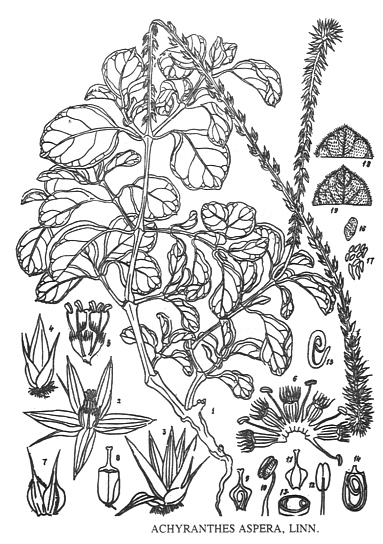

Zitierweise / cite as:
Carakasaṃhitā: Ausgewählte Texte aus der Carakasaṃhitā / übersetzt und erläutert von Alois Payer <1944 - >. -- Anhang A: Pflanzenbeschreibungen. -- Achyranthes aspera L. -- Fassung vom 2007-03-19. -- URL: http://www.payer.de/ayurveda/pflanzen/achyranthes_aspera.htm
Erstmals publiziert: 2007-03-19
Überarbeitungen:
Anlass: Lehrveranstaltung SS 2007
©opyright: Dieser Text steht der Allgemeinheit zur Verfügung. Eine Verwertung in Publikationen, die über übliche Zitate hinausgeht, bedarf der ausdrücklichen Genehmigung des Verfassers
Dieser Text ist Teil der Abteilung Sanskrit von Tüpfli's Global Village Library
WARNUNG: dies ist der Versuch einer
Übersetzung und Interpretation eines altindischen Textes. Es ist keine
medizinische Anleitung. Vor dem Gebrauch aller hier genannten Heilmittel wird
darum ausdrücklich gewarnt. Nur ein erfahrener, gut ausgebildeter ayurvedischer
Arzt kann Verschreibungen und Behandlungen machen!
Falls Sie die diakritischen Zeichen nicht dargestellt bekommen, installieren Sie eine Schrift mit Diakritika wie z.B. Tahoma.
Verwendete und zitierte Werke siehe: http://www.payer.de/ayurveda/caraka0001.htm

Abb.: Achyranthes aspera L.
[Bildquelle: Kirtikar-Basu, ©1918]
Drury:
"Achyranthes aspera (Linn.) N. O. Amarantaceae. Chirchirā, Chikrā, Hind. Agārā, Duk. Na-yurioi, Tam. Utta-reni, Antisha, Apa-margamu, Pratyak-pushpi, Tel. Katalāti, Mal. Opang, Benq.
Description.—Shrub about 6 feet; branches somewhat 4-sided; stem erect, pubescent; leaves on short petioles, obovate-rotund, abruptly attenuated at the base, pubescent; spikes virgate, acute, at first horizontal, afterwards reflexed; flowers purplish-green; bracts at first soft, soon becoming rigid and prickle-like ; capsules 5-seeded, reddish. Fl. nearly all the year.— Roxb. Fl. ind. i. 672.— Wight Icon. t. 1777.— Rheede, x. t. 78.—A. obtusifolia, Lam.-- Bengal Peninsula.
Medical Uses.—The seeds are given in hydrophobia, and in cases of snake-bites, as well as in ophthalmia and cutaneous diseases. The flowering-spikes rubbed with a little sugar are made into pills, and given internally to people bitten by mad dogs. The leaves taken fresh and rubbed to a pulp are considered a good remedy applied externally to the bites of scorpions. The ashes of the burnt plant mixed with conjee is a native remedy in dropsical cases. Astringent and diuretic properties are assigned to this plant, and Dr Cornish states having employed it largely in dropsy with favourable results. The whole plant, when incinerated, yields a considerable quantity of potash. These ashes, in conjunction with infusion of ginger, are likewise esteemed in dropsical affections. The flowering-spike has the repute in Oude and other parts of India of being a safeguard against scorpions, which it is believed to paralyse. It has also been used successfully as a local application in scorpion-stings and in snake-bites.—Pharm. of India. Long in Journ. of Agri. Hort. Soc. of India, 1858, x. 31. Madras Quart. Journ. of Med. Sc., 1862, iv. 10.—Wight. Ainslie. Hamilton."
[Quelle: Drury, Heber <1819 - 1872>: The useful plants of India : with notices of their chief value in commerce, medicine, and the arts. -- 2d ed. with additions and corrections. London : Allen, 1873. -- xvi, 512 p. ; 22 cm. -- s.v.]
Dutt:
"ACHYRANTHES ASPERA, Linn* Sans. apāmārga, kharamañjarī.
Vern. Āpāng, Beng. Laṭjirā, chirchirā, Hind.
This troublesome weed is chiefly valued on account of its ashes which contain a large quantity of potash. These are used in the preparation of alkaline medicines and caustic pastes, (see Alkaline ashes). The ashes mixed with orpiment are applied as a caustic to warts on the penis and other parts of the body.
Apāmārga taila. Take of sesamum oil four seers, the alkaline water prepared from the ashes of Achyranthes aspera sixteen seers, the ashes of the plant one seer, and boil them together in the usual way. This oil is poured into the meatus in cases of noise in the ears and deafness.
The weed itself is described as heating like fire, laxative and a promoter of secretions ; it is used in combination with other medicines of its class in ascites and anasarca, ( see Cedrus Deodara)."
[Quelle: Dutt, Uday Chand: The materia medica of the Hindus / Uday Chand Dutt. With a glossary of Indian plants by George King. -- 2. ed. with additions and alterations / by Binod Lall Sen & Ashutosh Sen. -- Calcutta, 1900. - XVIII, 356 S. -- S. 221.]